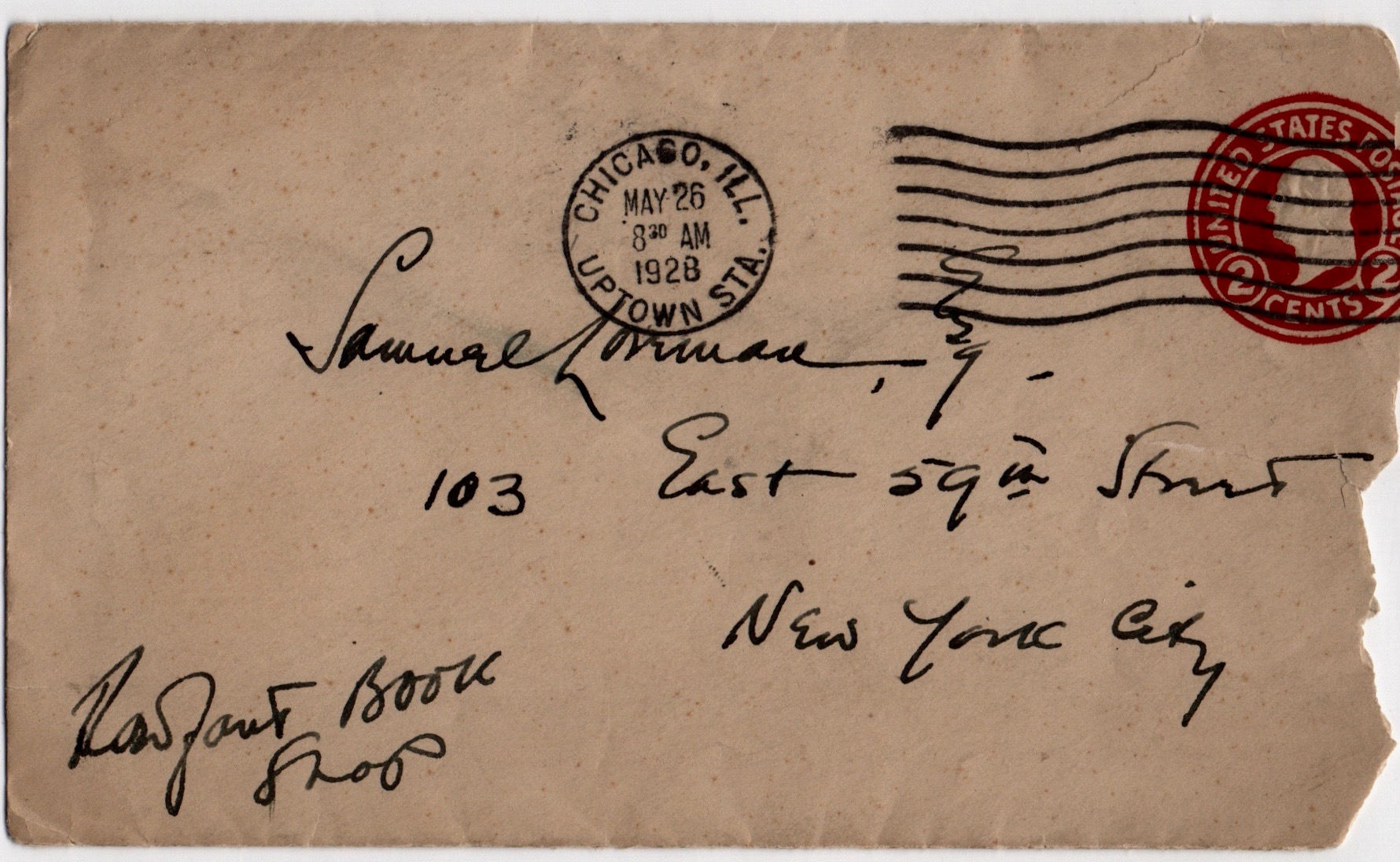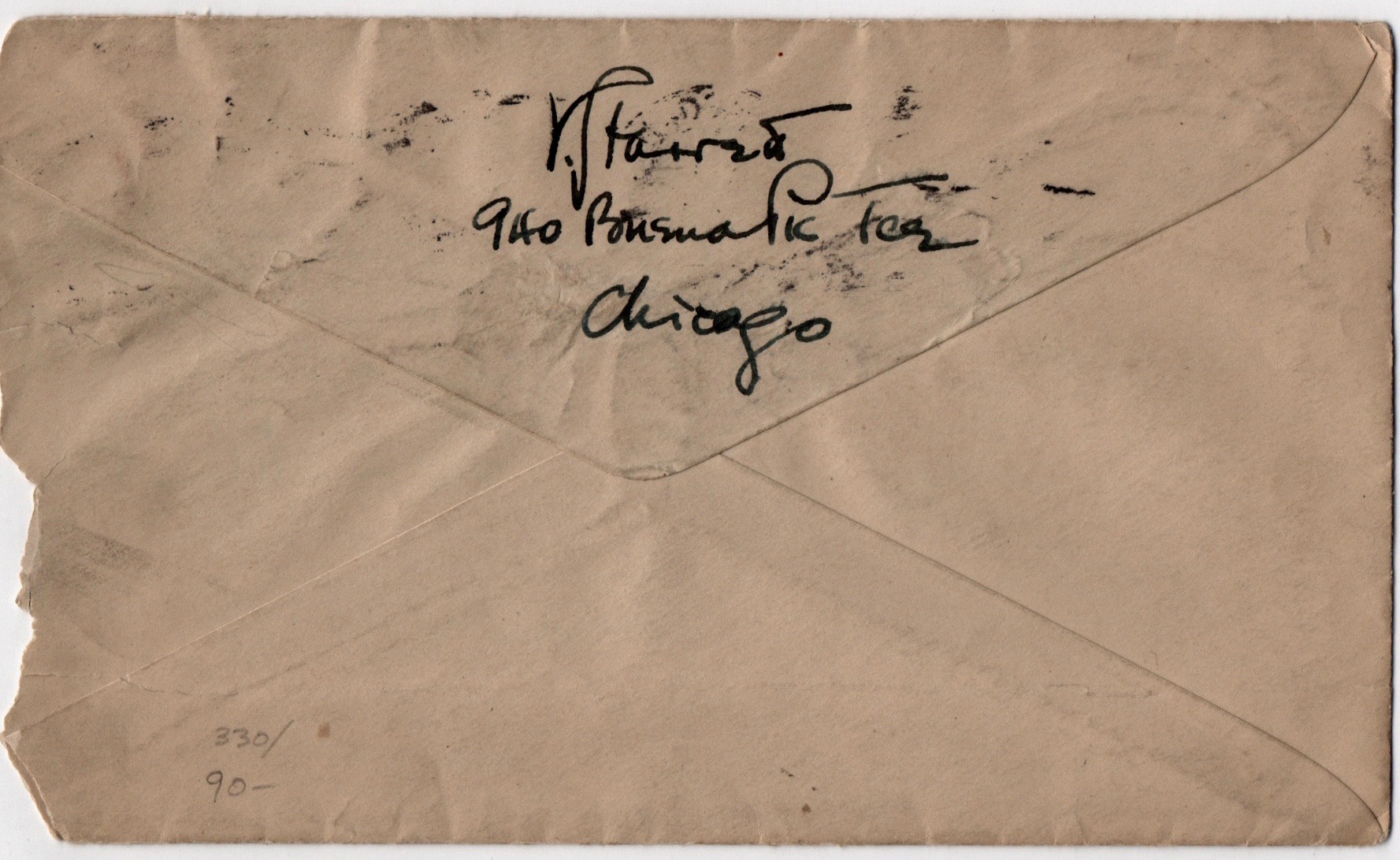The Loveman letter
A single letter can tell you a lot.
Anyone who has ever read Walter M. Miller Jr.’s A Canticle for Leibowitz knows the perils that come from making too much from a few scraps of paper. As Miller slyly asserts, a grocery list can become blown all out of proportion if it’s treated like a sacred object. So perspective is vital when dealing with scraps of paper from the past.
Still, we have recently acquired a letter from Vincent Starrett that deserves a few moments of attention. We’ll try to keep it in perspective.
Before we get to the contents of the letter, let’s look at the letter and its envelope in our best Sherlockian style.
The envelope:
Measuring 6X3.5 inches, it’s stood up pretty well to the last 89 years or so.
The red two-cent postage is embossed into the envelope’s upper right corner.
By the efficiency of the U.S. Postal Service, we know that it was cancelled at 8:30 a.m. on Saturday, May 28, 1928, from the Uptown Station of the Chicago, IL, post office.
Starrett’s sweeping hand has addressed it as follows:
Samuel Loveman Esq.
103 East 59th Street
New York City
In the lower left corner appears to be the words:
“Rowfont Book/Shop”
On the back of the envelope is Starrett’s return address, with his characteristic signature:
Vincent Starrett
940 Buena Park Terrace
Chicago
The letter: The paper is very thin, so thin in fact that when Starrett hit the period key on his manual typewriter, it sometimes went all the way through the page.
The paper itself measures 8.25 X 11.25 inches. It was folded in half, then in thirds to fit into the envelope. The type is pretty light. I’ve darkened the image a bit to make it more readable.
Now, on to the text.
We will take it one graph at a time, starting with the transcription, and then some annotations.
Salutation and First Paragraph:
Dear Sam:
Answering your inquiry at the close of item No. 263 in your amusing Catalogue No. 4: I was hard up. That’s why I sold a lot of my books. And I still miss them.
Sam, of course, was Samuel Loveman. While not well known today, he was actively engaged in the literary scene in his native Cleveland and later in New York for more than half a century. Loveman was friends with H.P. Lovecraft (whose 1915 poem “To Samuel Loveman, Esquire, on His Poetry and Drama, Writ in the Elizabethan Style" explains why Starrett addressed his letter to “Samuel Loveman, Esq.), and several pulp writers of the era, including Clark Ashton Smith and Frank Belknap Long and poet Hart Crane.
We don’t know what catalogue of Loveman’s Starrett is referring to. Perhaps Loveman was selling something of Starrett’s and made a comment about it in his catalog. At any rate, Starrett periodically found himself in dire financial straits and had to sell his books. Of course, he would turn around and start collecting again the next day. That’s part of the reason why so many books from his collection(s) are available for purchase even today.
As Starrett said elsewhere: “There is only one reason for selling one’s books, and that is poverty, there is no other justification.”
Second paragraph:
Starrett's 1928 "fantasia" piece, Seaports in the Moon. Sales were not going well.
Did you receive the packet of Bruce Roger’s, etc, sent you some time ago? How much do you owe me? I mean in trade? I should like to pick here and there in your good lists, but can’t run the risk of overshooting my credit. I am still reasonably hard up, and perhaps shall be until I have a royalty check. I hope you are helping out in that connection by urging Seaports in the Moon upon all your customers. And have you read it, yourself?
Bruce Rogers is probably the American typographer, whose professional career spanned more than 60 years. He was highly influential in his field and it would not be a surprise for a bibliofool (his term) like Starrett to have some of Rogers’ works.
Seaports in the Moon is one of my favorite Starrett works. A fantasy that blends historic and literary characters, it’s the tale of a bottle of water from the fountain of youth and how the bottle travels from era to era. Highly imaginative, it was unlike anything else Starrett wrote. It was also a book that did not sell well, much to the author’s disappointment.
Decades later, he would list Seaports in the Moon as one of his most beloved works. The book is now a collector’s item for those interested in the history of fantasy and science fiction. One chapter from the book involving Edgar Allan Poe has been anthologized often, as I recounted here.
Mrow. They sure knew how to do book covers back in the '20s, eh?
Third paragraph:
If it is still available, I should like your copy of Jezebel Pettyfer, item 425, priced at $15.00. There are others I should like, too, including the Bierce presentation copies and the Aries Press “Ghost Ship,” etc; but I can not commit myself until I know where we stand. Anyway, they will probably all be gone when you get this letter.
Is it just me, or does Starrett sound a little grumpy? No doubt having to sell his books was a blow, but it was a circumstance of his own making, was it not? And that comment about the books he wants “will probably all be gone” might still be an echo of his losing out on one of Poe’s most valuable works by only 30 minutes.
The Wooings of Jezebel Pettyfer was a controversial novel by British critic Haldane Macfall, a writer Starrett admired to the point of hero worship. In his 1923 book, Buried Caesars, Starrett enthusiastically recommends the book and its author, about whom Starrett predicts, “it is primarily as a novelist that Haldane Macfall will figure in the literary chronicles of the future.” Starrett calls Pettyfer “a West Indian blend of Pickwick, The Three Musketeers, and the Spanish romances of roguery.” Macfall’s “uncensored and uproarious humor” coupled with “the tumult and gusto of his style” make it a book Starrett enthusiastically recommends to all. We will have more to say about Macfall at a later time.
Starrett also asks after “the Bierce presentation copies and the Aries Press ‘Ghost Ship’…” We’ve already examined Starrett’s fascination for Bierce. (Bierce aficionado Don Swaim has likewise considered the relationship between the two men in an essay I can recommend.)
The Ghost Ship was a novel by British poet and short story writer Richard Middleton, published in 1926 in western New York by Aries Press in a limited edition. The edition can command prices in the hundreds of dollars today. It sounds like it was comparably expensive in 1928.
Some of Lovecraft's letters to Loveman and Starrett were collected into this little booklet back in the 1994 by the Necronomicon Press.
Final paragraphs:
I hope you are doing well, and I hope you like your new shop. Are you somewhere (near) the Park Book Shop?
Kindest regards and all good wishes.
Sincerely,Vincent Starrett (signature)
My interests are still Stephen Crane, Bierce, and the ana of “Edwin Drood.” Let me hear when you have anything in my line.
I’m most intrigued by the postscript, which identifies the areas Starrett was collecting. He had already written bibliographies of Stephen Crane and Ambrose Bierce by this point. And his interest in Charles Dickens' unfinished novel, The Mystery of Edwin Drood, would result in Starrett editing the Heritage Press edition of the book in 1941, 13 years after this letter was sent.
Finally, Starrett does not mention an interest in Sherlock Holmes or the work of Sir Arthur Conan Doyle, even though we know that Starrett was already amassing an impressive Holmes collection at this point.
So that’s it. One letter that offers a little insight into Starrett’s mind in the spring of 1928. It’s not enough to start a new religion, but it does offer food for thought on a warm day in March.
As for me, I'm going to look for an affordable first edition of The Wooings of Jezebel Pettyfer.
Purely for research reasons, you understand.


